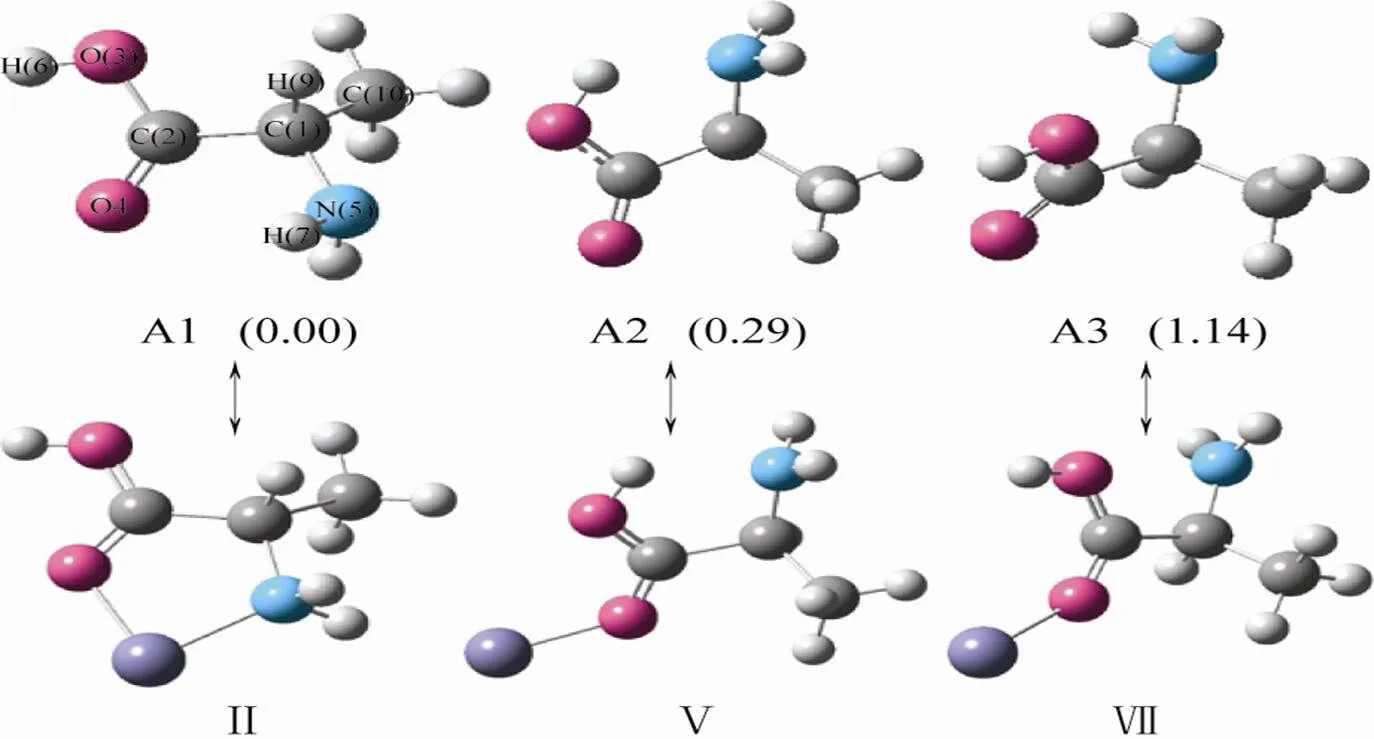Proton Transfer Mechanism of Alanine Induced by Zn2+: a Theoretical Study①
MENG Xiang-Jun
?
Proton Transfer Mechanism of Alanine Induced by Zn2+: a Theoretical Study①
MENG Xiang-Jun②
(063000)
In this paper, proton transfer mechanism of alanine induced by Zn2+was investiga- ted by the CCSD/6-31++G**//B3LYP/6-31++G** method. Six neutral complexes and one ampho- teric complex were optimized, among which the amphoteric complex was the most stable with binding energy of 201.92 kcal·mol?1. In addition, the rotation of intramolecular single bond leads to the neutral configuration conversion, in which the rotation energy barriers of C–C single bonds are lower than 10.51 kcal·mol?1, and those of C–O single bonds range among 9.53~17.50 kcal·mol?1. On the other hand, the proton transfers among the carboxylic oxygen atoms can also result in the neutral configuration conversion, whose energy barriers of forward/back reaction are 53.90 and 32.46 kcal·mol?1, respectively. In detail, the proton transfers from carboxylic group to amino lead to their configuration conversion from neutral to amphoteric. Furthermore, under the catalysis of Zn2+, there was no energy barrier in this reaction. The conversion route from the most stable neutral configuration II to the most stable amphoteric configuration I was: Ⅱ →Ⅱ-Ⅲ → Ⅲ → Ⅲ-Ⅵ → Ⅵ → Ⅴ-Ⅵ → Ⅴ →Ⅰ-Ⅴ →Ⅰ, with the energy barrier to be 64.64 kcal·mol?1.
complexes, alanine, Zn2+, transition state, reaction route, mechanism
1 INTRODUCTION
As an important kind of living matter, amino acids can be involved in many physiological processes, so their structural and property changes during the biochemical reactions seem very interesting and have captured the interest of researchers for many years[1]. It is universally accepted that the intramole- cular proton transfers make the amino acid converse between neutral and amphoteric configurations. Therefore, the study about the inducing factors and the mechanism of i intramolecular proton transfers seems very significant. In gas phase, amino acids are neutral, but in liquid phase they are amphoteric[2]. So far, much attention about the proton transfer mecha- nisms of amino acids has been paid to their behavior in aqueous solution[3].
In recent years, great progress has been made in the structures, properties and coordinated interac- tions of metal/amino acid system[4-17]. For the struc- tures and properties of biological molecule/metal ion systems, their behavior in gas phase differs greatly from those in liquid phase. In the gas phase reaction, the solvent and ion pair effects could not be taken into account, but their essential chemical and phy- sical properties can be given. Therefore, in recent ten years, gas phase chemistry has developed greatly. Mass spectrum (MS) technology is an important method for the study of metal ion/biological mole- cule in gas phase[10]. However, quantum chemistry method can describe the structures and functions of this system accurately[11]. According to previous literatures[14-17], many metal ions (Mn+) can induce intramolecular proton transfer among amino acids (AA), which can stabilize the amphoteric ions.For example, the isolated amphoteric proline (Pro) is unstable[12], but after interacting with Na+, the energy of amphoteric [Na+·Pro] complex is 2.87~4.30 kcal·mol?1lower than that of the most stable complex[13, 14]. The experimental results of isolated proline[15]and [Na+·Pro] complex[16]are in good agreement with their theoretical results.
Up to now, many metal/amino acid [Mn+·AA] systems[4-17]have been investigated, and most attention is paid to their static structures and pro- perties. To our knowledge, the proton transfer me- chanism induced by metal ions is still much less. In 2000, Pulkkinen S..[4]carried out the study about proton transfer reactions of glycine induced by Na+, Mg2+, Cu+, Ni+and Cu2+with B3LYP method, in which the inducing abilities and stabilization effects of different metal ions to proton transfer were disclosed. But this work[4]only reveals one step of the reaction (corresponding to the configuration conversion from V to I via the transition state I-V, in Fig. 1), and the selected reactant (configuration V) was not the most stable structure among neutral configurations. So, the real conversion mechanism from the most stable neutral to amphoteric con- figuration is still unclear. Alanine (Ala) is the sim- plest chiral amino acid, and Zn2+plays an important role in the growth of organism (so-called “flower of life”). Therefore, in our work, the [Zn2+·Ala] com- plex was selected as models, and the study about this system has not been reported so far. In this work, the stabilities of [Zn2+·Ala] complex and proton transfer mechanism of alanine induced by Zn2+are discussed.
2 CALCULATION METHODS
B3LYP method has proved its reliability in the theoretical study of metal/amino acid system, in which the 6-311+G(d)[17], 6-31++G(d,p)[8]and 6-311+G(d,p)[9]basis sets were used. Thereby, in our work, the structural optimizations of [Zn2+·Ala] complexes were carried out with B3LYP/6-31++G** method, and the transition states were searched with QST2 method. All the optimized structures were verified by frequency validation and the transition states were proved by IRC verification. Afterwards, the zero-point energy correction was executed on all the configurations with their energy (Ecom) obtained at 0 K, and the binding energies ΔEb(ΔEb= Ecom– EAla– EZn2+), relative energies ΔEr(ΔEr= Ecom– Ecom,min) and activation energies Ea(Ea') of the forward/back reactions are also given. Finally, all the energies were corrected by the single-point energies of each configuration calculated at the CCSD/6- 31++G** level, upon which the conversion routes and energy level diagrams were given. The natural charges (NPA) were calculated by the NBO method, and all the calculations were carried out with the G03 program[18].
3 RESULTS AND DISCUSSION
3. 1 Structures and stabilities
Seven optimized stable configurations are shown in Fig. 1 and labeled according to their stabilities. The most stable configuration I is amphoteric and the rest six are neutral. The seven stable configura- tions converted via six transition states which were named according to their reactants and products. For comparison and discussion, all the configurations are listed in Fig. 1 according to their conversion routes, and the atomic labels are the same (configuration II, Fig. 1).
The first frequency1and second frequency2of all configurations are given in Table 1. The positive value of1indicates their stabilities, and the nega- tive1and positive2suggest their transition state nature. The structural parameters of these structures can be seen in the supplemental materials. ΔEband ΔErin Table 1 are the binding and relative energies in kcal·mol?1.
As shown in Fig. 1 and Table 1, we can draw the following conclusions: (1) Zn2+coordinates to alanine with bis-dentate (configurations I and II) and mono-dentate (configurations V and VI) coordina- tion modes. The most stable amphoteric configura- tion I and neutral configuration II adopt bis-dentate mode with binding energies of 201.92 and 199.51 kcal·mol?1, respectively. (2) Oxygen atom on the carboxylic group exhibits the strongest coordination ability (all the oxygen atoms take part in coor- dination except that in configuration IV).

Table 1. Vibration Frequency (v1 and v2), ΔEb and ΔEr of [Zn2+·Ala]

Fig. 1. Configurations of [Zn2+·Ala] complexes and their conversion routes
In the transition states, configuration conversion from V to VI is achieved via the rotation of C(1)– C(2) single bond with forward/back energy barriers of 10.51 and 0.04 kcal·mol?1, respectively. Similarly, configuration conversions from II to III, VI-VII are carried out via the rotation of C(2)–O(3) bond with energy barriers ranging among 9.53~17.50 kcal·mol?1. I-V is the transition state with H(6) locating between the carboxylic and amino groups, interestingly. The proton transfer from carboxylic to amino groups is barrier free (Ea' = –4.52 kcal·mol?1). II-IV is the transition state with H(6) transiting between two carboxylic oxygen atoms, whose forward/back barriers are 53.90 and 32.46 kcal·mol?1. Transition state II-VI indicates the formation of Zn–N(5) bond with energy change to be 54.96 kcal·mol?1(the energy difference between III-VI and III).
The binding energies of all stable structures seem high (larger than 136.70 kcal·mol?1), which are much higher than those in the configuration con- versions. So, conclusion could be drawn that the configuration conversion is thermodynamic control rather than dynamic control.
3. 2 Effect of Zn2+ on the alanine
The effect of Zn2+on alanine can be discussed by analyzing the change of its structural parameter. Herein, three most stable configurations of alanine were selected[19](A1, A2 and A3 in Fig. 2, the relative energies in the bracket were calculated at the B3LYP/6-31++G** level in kcal·mol?1). As shown in Fig. 2, when Zn2+interacts with A1, configuration II can be generated more easily. Similarly, when it interacts with A2 and A3, configurations V and VII are produced.

Fig. 2. Most stable configurations of alanine and their corresponding [Zn2+·Ala] complexes
The NPA charge Q, bond lengths RO(3)-H(6)of covalent bond BO(3)-H(6)(pm), and the changes (ΔQ, ΔRO(3)-H(6)) after interacting with Zn2+are listed in Table 2.

Table 2. NPA Charge Q, Bond Lengths RO(3)-H(6) of Covalent Bond BO(3)-H(6)(pm), and the Changes (ΔQ, ΔRO(3)-H(6)) of Three Stable Alanines
As revealed by Table 2, in alanine, C(1), O(3), O(4) and N(5) are all negative, and the rest atoms are positive. The charge change ΔQ indicates that the interaction with Zn2+leads to the increase of positive atoms with amount lower than 0.13. In addition, negative charges on O(4) increase with the amount of 0.12~0.14, and those on O(3) are decreased by 0.10~0.14. In configuration II, the formation of coordination bond between Zn2+and N(5) results in its increase of negative charge (increasing amount: 0.12). In configurations V and VII, the negative charges on N(5) decrease greatly (larger than 0.14), which weakens the Column interaction around N(5). The formation of complex decreases the positive charge on Zn2+(larger than 0.40), suggesting that the electronic cloud tends to the Zn center.
ΔRO(3)-H(6)illustrates that the interaction between Zn2+and alanine leads to the elongation of covalent bonds around H(6) (larger than 0.7 pm). Thus Zn2+can activate the covalent bond BO(3)-H(6), which can be convenient for the proton transfer of H(6).
In order to disclose the interaction between Zn2+and alanine deeply, the vibration frequency(cm-1) of all configurations and their changes (Δ) are listed in Table 3. As shown in Table 3, after the Zn2+interacts with alanine, chemical bond BC(2)-O(3)(ΔC(2)-O(3)are all positive, which are larger than 382.8 cm-1) is greatly inactivated, but BC(2)-O(4), BC(1)-C(2)and BO(3)-H(6)are activated. In all, Zn2+can be convenient for the proton transfer.

Table 3. Vibration Frequency v (cm-1) of All Configurations and Their Changes (Δv) of Three Stable Alanines
3. 3 Configuration conversion route and mechanism
Configuration conversion route and energy level are given in Fig. 3. As revealed by Fig. 3, the con- version route from the most stable neutral configura- tion II to the smallest configuration I is: Ⅱ →Ⅱ-Ⅲ → Ⅲ → Ⅲ-Ⅵ → Ⅵ → Ⅴ-Ⅵ → Ⅴ →Ⅰ-Ⅴ →Ⅰ. There are two routes for the conversion from II to higher energy configurations. The first isⅡ →Ⅱ-Ⅳ → Ⅳ, and the other is to Ⅶ via Ⅲ or Ⅵ. Here we set the route of Ⅱ→Ⅰ as an example to introduce the proton transfer mechanism of alanine induced by Zn2+. In the most stable neutral configuration II, Zn2+coordinates to O(4) and N(5) with binding energy of 199.51 kcal·mol?1and relative energy of 2.41 kcal·mol?1.
During the rotation of C(2)–O(3) bond, whenC(1)–C(2)–O(3)–H(6)rotates from –179.5 to –88.2° (see the structural parameter Table), configuration II generates the transition state Ⅱ-Ⅲ with energy increase of 17.52 kcal·mol?1. Afterwards, C(2)–O(3) rotates further with ΦC(1)–C(2)–O(3)–H(6)being –2.6 °. The transition state Ⅱ-Ⅲ can translate into con- figuration III with energy decrease of 10.24 kcal·mol?1. The relative energy of configuration III is 9.68 kcal·mol?1.
In configuration III, Zn2+coordinates to N(5) with bond length of 202.0 pm. During the breaking of Zn–N(5) bond, when the bond distance is 379.7 pm, transition state Ⅲ-Ⅵ is generated with energy increase of 54.95 kcal·mol?1. Afterwards, when the Zn–N(5) bond distance is 492.6 pm, configuration VI is produced with energy decrease of 5.55 kcal·mol?1. The relative energy of configuration VI is 59.09 kcal·mol?1.
Configuration VI can translate into V via the rotation of C(1)–C(2) bond. WhenN(5)–C(1)–C(2)–O(3)rotates from 81.5 to 71.0°, configuration VI con- verses into transition state Ⅴ-Ⅵ with energy increase of 0.05 kcal·mol?1. Afterwards, when ΦN(5)– C(1)–C(2)–O(3)reaches –1.7°, transition state Ⅴ-Ⅵ translates into V with energy decrease of 10.51 kcal·mol?1. The relative energy of configuration V is 48.63 kcal·mol?1.
In configuration V, H(6) locates between O(3) and N(5) with H(6)–O(3) and H(6)–N(5) distances of 99.5 and 208.5 pm, respectively. During the transfer of H(6) to N(5), when the H(6)–O(3) and H(6)–N(5) distances are 105.7 and 166.7 pm, transition state Ⅰ-Ⅴ is generated with energy decrease of 4.52 kcal·mol?1(it is a barrier free process). Afterwards, H(6) transfers to N(5) further. When the H(6)–O(3) and H(6)–N(5) distances are 258.2 and 104.9 pm, configuration I is given with energy decrease of 44.11 kcal·mol?1. Configuration I exhibits the lowest energy. The configuration conversions from II to IV and VII are similar.
4 CONCLUSION
In this paper, proton transfer mechanism of alanine induced by Zn2+was investigated by CCSD/6-31++G**//B3LYP/6-31++G** method, and the following conclusions can be drawn: (1) Zn2+can interact with alanine to produce six neutral com- plexes and one amphoteric complex, whose binding energies are larger than 136.70 kcal·mol?1. The amphoteric complex is the most stable with binding energy of 201.92 kcal·mol?1. These seven con- figurations can translate into other configurations via six transition states with the highest energy barrier of 74.75 kcal·mol?1. (2) The conversions among neutral molecules can be achieved via the rotation of intra- molecular single bond. They can be also realized via the proton transfer among carboxylic oxygen atoms. The rotation energies of C–C bond are lower than 10.51 kcal·mol?1, and those of C–O range among 9.53~17.50 kcal·mol?1. The forward/back reaction energy barriers of proton transfer among carboxylic oxygen atoms are 53.90 and 32.46 kcal·mol?1.
(3) After Zn2+interacts with alanine, the electronic cloud tends to the Zn center, which can be conve- nient for the proton transfer. The proton transfer from carboxylic to amino group induced by Zn2+is a barrier free process, which makes the neutral con- figuration translate into amphoteric configuration.
(4) The conversion route from the most stable neutral configuration II to the configuration I is: Ⅱ → Ⅱ-Ⅲ → Ⅲ → Ⅲ-Ⅵ → Ⅵ → Ⅴ-Ⅵ → Ⅴ→Ⅰ-Ⅴ →Ⅰwith the highest energy barrier of 64.64 kcal·mol?1.
(1) Zhong, L; Hu, Y. J.; Xing, D.; Zou, H. Microsolvation process of biomolecules.2010, 22, 1–7.
(2) Bonaccorsi, R.; Palla, P.; Tomasi, J. Conformational energy of glycine in aqueous solutions and relative stability of the zwitterionic and neutral forms.initio study.1984, 106, 1945–1950.
(3) a) Aikens, C. M.; Gordon, M. S. Incremental solvation of nonionized and zwitterionic glycine.2006, 128, 12835–12850; b) Bachrach, S. M. Microsolvation of glycine: a DFT study.2008, 112, 3722–3730; c) Meng, X. J.; Guo, X. S.; Jia, J. F.; He, Q.; Wang, Y. B. Theoretical study on structures and properties of gly-(H2O)5.2011, 69, 25–36.
(4) Pulkkinen, S.; Noguera, M.; Rodr?′guez-Santiago, L.; Sodupe, M.; Bertran, J. Gas phase intramolecular proton transfer in cationized glycine and chlorine substituted derivatives (M-gly, M = Na+, Mg2+, Cu+, Ni+, and Cu2+): existence of zwitterionic structures?2000, 6, 4393–4399.
(5) Strittmatter, E. F.; Lemoff, A. S.; Williams, E. R. Structure of cationized glycine, Gly·M2+(M = Be, Mg, Ca, Sr, Ba), in the gas phase: intrinsic effect of cation size on zwitterion stability.2000, 104, 9793–9796.
(6) Remko, M.; Rode, B. M. Effect of metal ions (Li+, Na+, K+, Mg2+, Ca2+, Ni2+, Cu2+and Zn2+) and water coordination on the structure of glycine and zwitterionic glycine.2006, 110, 1960–1967.
(7) Bush, M. F.; Oomens, J.; Saykally, R. J.; Williams, E. R. Effects of alkaline earth metal ion complexation on amino acid zwitterion stability: results from infrared action spectroscopy.2008, 130, 6463–6471.
(8) Remko, M.; Fitz, D.; Rode, B. M. Effect of metal ions (Li+, Na+, K+, Mg2+, Ca2+, Ni2+, Cu2+and Zn2+) and water coordination on the structure and properties of L-histidine and zwitterionic L-histidine.2010, 39, 1309–1319.
(9) Armentrout, P. B.; Chen, Y.; Rodgers, M. T. Metal cation dependence of interactions with amino acids: bond energies of Cs+to Gly, Pro, Ser, Thr, and Cys.2012, 116, 3989?3999.
(10) Armentrout, P. B.; Gabriel, A.; Moision, R. M. An experimental and theoretical study of alkali metal cation/methionine interactions.2009, 283, 56–68.
(11) Alagona, G.; Ghio, C. Plicatin, B. conformational landscape and affinity to copper (I and II) metal cations. a DFT study.2009, 11, 776–790.
(12) Lee, K. M.; Park, S. W.; Jeon, I. S.; Lee, B. R.; Ahn, D. S.; Lee, S. Computational study of proline – water cluster.2005, 26, 909–912.
(13) Marino, T.; Russo, N.; Toscano, M. Interaction of Li+, Na+, and K+with the proline amino acid. complexation modes, potential energy profiles, and metal ion affinities.2003, 107, 2588–2594.
(14) Moision, R. M.; Armentrout, P. B. The special five-membered ring of proline: an experimental and theoretical investigation of alkali metal cation interactions with proline and its four- and six-membered ring analogues.2006, 110, 3933–3946.
(15) Lesarri, A.; Mata, S.; Cocinero, E.; Blanco, S.; Lopez, J. C.; Alonso, J. L. The structure of the neutral proline.2002, 41, 4673–4676.
(16) Wincel, H. Hydration energies of sodiated amino acids from gas-phase equilibria determinations.2007, 111, 5784–5791.
(17) He, Q.; Wang, K. C.; Zhou, L. X. Theoretical studies for the interaction between glycine and divalent metal cations.2007, 40, 36–41.
(18) Frisch, M. J.; Trucks, G. W.; Schlegel, H. B.; Scuseria, G. E.; Robb, M. A.; Cheeseman, J. R.; Montgomery, J. A. Jr.; Vreven, T.; Kudin, K. N.; Burant, J. C.; Millam, J. M.; Iyengar, S. S.; Tomasi, J.; Barone, V.; Mennucci, B.; Cossi, M.; Scalmani, G.; Rega, N.; Petersson, G. A.; Nakatsuji, H.; Hada, M.; Ehara, M.; Toyota, K.; Fukuda, R.; Hasegawa, J.; Ishida, M.; Nakajima, T.; Honda, Y.; Kitao, O.; Nakai, H.; Klene, M.; Li, X.; Knox, J. E.; Hratchian, H. P.; Cross, J. B.; Adamo, C.; Jaramillo, J.; Gomperts, R.; Stratmann, R. E.; Yazyev, O.; Austin, A. J.; Cammi, R.; Pomelli, C.; Ochterski, J. W.; Ayala, P. Y.; Morokuma, K.; Voth, G. A.; Salvador, P.; Dannenberg, J. J.; Zakrzewski, V. G.; Dapprich, S.; Daniels, A. D.; Strain, M. C.; Farkas, O.; Malick, D. K.; Rabuck, A. D.; Raghavachari, K.; Foresman, J. B.; Ortiz, J. V.; Cui, Q.; Baboul, A. G.; Clifford, S.; Cioslowski, J.; Stefanov, B. B.; Liu, G.; Liashenko, A.; Piskorz, P.; Komaromi, I.; Martin, R. L.; Fox, D. J.; Keith, T.; Al-Laham, M. A.; Peng, C. Y.; Nanayakkara, A.; Challacombe, M. P.; Gill, M. W.; Johnson, B.; Chen, W.; Wong, M. W.; Gonzalez, C.; Pople, J. A.., Pittsburgh PA 2003.
(19) Balabin, R. M. Conformational equilibrium in alanine: focal-point analysis andlimit.2011, 965, 15–21.
13 August 2013;
20 March 2014
① Project supported by New Biological and Chemical Technology Key Laboratory of Tangshan (12150224B-2) and Science Foundation of Tangshan Normal University (2013D02)
. E-mail: xjmeng_1974@126.com
- 結(jié)構(gòu)化學(xué)的其它文章
- A 3-fold Interpenetrated lvt Cd(II) Network Constructed from 4-[(3-pyridyl)methylamino]benzoate Acid①
- Synthesis and Crystal Structure of a New Complex [Cu(C14H9O3)2(C5H5N)2(C2H5OH)2]①
- Quantum Chemical Study on the Structural Characteristics and Stability of AlSn±Clusters①
- Structure and Magnetic Properties of a Bipyridine-bridged One-dimensional Ni(II) Coordination Polymer①
- Tuning of NaTaO3 Band Structure through Mn2+ Ion Doping and the Enhanced Visible Light Response①
- Chiral Resolution of β-dl-Phenylalanine Using Chiral Macrocyclic Nickel(II) Complexes①

